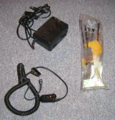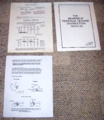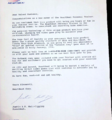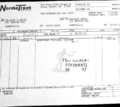HeartBeat Catalyst
From Sega Retro
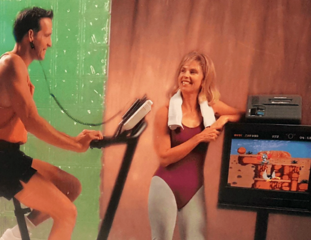
| ||||||||||
| HeartBeat Catalyst | ||||||||||
|---|---|---|---|---|---|---|---|---|---|---|
| Made for: Sega Mega Drive | ||||||||||
| Manufacturer: HeartBeat Corporation[1] | ||||||||||
| Type: Miscellaneous | ||||||||||
|
This short article is in need of work. You can help Sega Retro by adding to it.
The HeartBeat Catalyst is a third-party Sega Mega Drive exercise peripheral with included body-mounted fitness sensors which reads heart rate, motion, and skin salinity levels for in-game feedback.[1] Developed by American video game hardware developer HeartBeat Corporation and primarily sold alongside the Personal Trainer, it was released exclusively in the United States in November 1993.[2] Notable for having a production run of only 1,000 units, and sold with the exclusive pack-in game Outback Joey, both are considered some of the rarest pieces of Mega Drive history in existence.[3]
Contents
Hardware
The HeartBeat Catalyst is a body-mounted fitness sensor hardware peripheral which reads players' heart rate, motion, and skin salinity levels for in-game feedback, and is compatible with any Mega Drive system. Contrary to popular belief, it does not require the Personal Trainer to function, with the Catalyst even being sold separately for those who already owned a Mega Drive.[4][5] The most notable game developed to utilize this hardware, Outback Joey, uses this feedback to control the running speed of its player character, and encourages maintaining a consistent heart rate through exercise. Each Catalyst game features the ability to view user workout statistics with each new stage completed, allowing up to 4 players to further study the effects of their exercise over the most recent 3 months of play.[6]
The Catalyst is operated by plugging its specialized Processor adapter[7] into the Mega Drive's first controller port. Both sensor cables are then plugged into the device, as are the optional fitness bike-themed Control Pads. The main sensor, the Pulse Monitor, is attached to the body with a gentle earlobe clip for heartrate detection. The second, the Optical Sensor, is affixed to a piece of home exercise equipment like a stationary bicycle to measure the equipment's movement, such as how fast the user is pedaling. A pair of Control Pads are included as well, designed to attach to exercise equipment for easy access during workouts (although any Control Pad can also be used). HeartBeat Corporation stated the Catalyst was designed with exercise bikes, stairclimbers, treadmills, and ski machines in mind.
List of games
- Outback Joey (1993)
- NHLPA Hockey (1994)
- Outworld 2375 AD (1994)
- PGA Tour Golf II (1995)
History
The Catalyst was released exclusively in the United States in late 1993, with its fitness sensing capabilities only being utilized in four total games. Although ambitious, HeartBeat Corporation's plans to find a profitable niche in the video game market ultimately failed, and the company fell into liquidation only a couple years after its release.
Background
The dawn of the 1990s saw the widespread success of home video game consoles, particularly from Nintendo and Sega. As technology continued to both evolve and grow cheaper, game consoles were becoming more and more capable, and the idea of combining video games with existing technologies grew more enticing as well. One of these ideas would be the concept of "exertainment" - exercise entertainment. As gaming is generally a sedentary activity, companies have long-since tried to create novel ways of exercising while playing video games. Most of these attempts have ended in obscurity or outright failure for a number of reasons, and it was only with the coming of modern games like Wii Fit that the idea of combining exercise and games gained any reasonable traction with the general public.
Prerelease
The peripheral, alongside its dedicated software Outback Joey, appeared at Winter CES 1994[8][9] and was used to demonstrate how the specialized fitness sensors could be utilized with a traditional video game. Additionally, the company claimed that an upcoming special version of Earthworm Jim which utilized the HeartBeat Catalyst was in development, but ultimately was never released.
Release
The HeartBeat Catalyst was released on November 24, 1993, and was available for purchase for $299.95[10] in a bundle which included the Personal Trainer.[2] For buyers who already owned a Sega Mega Drive, the Catalyst hardware was available for purchase separately for $199.95 (still including Outback Joey.)[2]
Confusingly, both the Catalyst itself and the Personal Trainer bundle were sold under the combined "Personal Trainer" branding for the entirety of its existence, with the name Catalyst seemingly being created after the system's initial failure. This created long-standing confusion over what was necessary to use the peripheral or play the games, with consumers in particular believing the special Personal Trainer system was required to operate the hardware. The creation of Catalyst branding for the sensor peripheral was likely meant to address this confusion, as later promotional material emphasizes the separate nature of the Catalyst for existing Mega Drive owners. However, software produced as late as 1995 were still listing the "Personal Trainer" as a requirement for play[11], suggesting that even HeartBeat Corporation themselves were unable to consistently brand their only product.
Failure
Sales of the Catalyst were poor, and HeartBeat encountered significant difficulties in marketing and selling the unique device, resulting in a significant price drop of $100[2] by April 1995. Less than one year after its release, the company cancelled production of any remaining hardware and software projects while it tried to locate other sources of funding, and transferred the entirety of its tangible assets to a newly-formed sister corporation.[2] The new affiliated company did not produce or develop any content (appearing only to exist as a means to sell as much remaining HeartBeat products as they could), with later releases being manufactured on such a cheap budget that they were frequently mistaken for unfinished prototypes. Ultimately, this did little to turn around sales, and HeartBeat Corporation was later officially dissolved on September 8, 1997.[2]
Magazine articles
- Main article: HeartBeat Catalyst/Magazine articles.
Promotional material
- Main article: HeartBeat Catalyst/Promotional material.
Photo gallery
Personal Trainer, controllers, cables, and Catalyst
A letter from HeartBeat Corporation concerning shipment of replacement parts.
A letter included with early copies of the system regarding an upcoming Outback Joey software revision.
A 1994 purchase receipt from exercise machine manufacturer NordicTrack.
External links
- HeartBeat Catalyst at The Video Game Kraken
- Technology adds new thrills to boring exercise equipment article by Bob Condor at The Chicago Tribune (archive)
- THE GOODS: Technowatch: Gone! Last of the Excuses article by Lynn Simross at The Los Angeles Times (archive)
References
- ↑ 1.0 1.1 Sega Visions, "October/November 1993" (US; 1993-xx-xx), page 108
- ↑ 2.0 2.1 2.2 2.3 2.4 2.5 2.6 http://videogamekraken.com/heartbeat-personal-trainer-catalyst (Wayback Machine: 2021-04-14 05:43)
- ↑ https://www.sega-16.com/2004/08/genesis-accessory-peripheral-guide/ (Wayback Machine: 2013-10-11 18:57)
- ↑ https://www.latimes.com/archives/la-xpm-1994-06-24-ls-7959-story.html (Wayback Machine: 2021-10-04 06:35)
- ↑ https://www.chicagotribune.com/news/ct-xpm-1994-02-24-9402240306-story.html (Wayback Machine: 2022-01-29 12:22)
- ↑ Sega Visions, "October/November 1993" (US; 1993-xx-xx), page 110
- ↑ File:HeartBeatPersonalTrainer US brochure.pdf, page 4
- ↑ GamePro, "April 1994" (US; 1994-xx-xx), page 92
- ↑ Mega, "March 1994" (UK; 1994-02-17), page 12
- ↑ MAN!AC, "03/94" (DE; 1994-02-09), page 8
- ↑ File:PGATourGolfIIcatalyst MD US cover.png
| HeartBeat Catalyst | |
|---|---|
| Topics | Magazine articles | Promotional material | Personal Trainer | HeartBeat Corporation |
| Games | NHLPA Hockey | Outback Joey | Outworld 2375 AD | PGA Tour Golf II |




